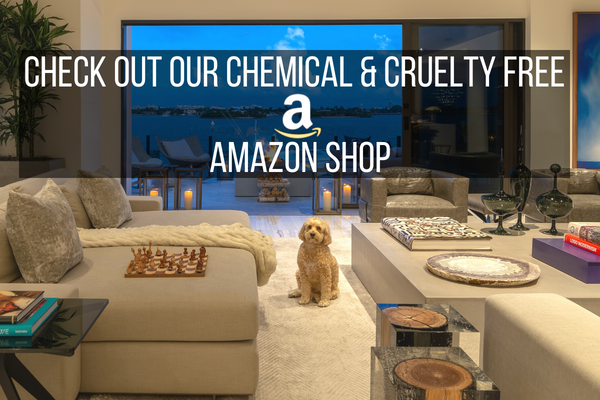A Guide To designing a Non-Toxic Bathroom
Your bathroom is meant to be a place of relaxation and rejuvenation, but it can also be a source of harmful chemicals and toxins. Do you know that indoor air pollution is 2-5 times higher than outdoor air pollution? And that many common bathroom materials, such as cleaning products, paints, and plastics, can emit harmful chemicals that can negatively impact your health and the environment?
That's why non-toxic bathroom design is so important. Not only does it improve your health and the environment, but it also enhances the overall look and feel of your bathroom. Moreover, non-toxic bathroom design offers a wide range of benefits, including improved indoor air quality, reduced exposure to harmful chemicals, and a healthier living environment. It also promotes sustainability by using eco-friendly materials and reducing water usage.
By making simple changes, you can transform your bathroom into a healthy, sustainable, and beautiful space. In this guide, we will cover everything you need to know about creating a non-toxic bathroom, from choosing non-toxic materials to designing a functional and comfortable layout. So, let's get started on your journey to a healthier bathroom!
Getting Started with Non-Toxic Bathroom Design
It is really easier than you think. The first step would be to assess what is the condition of your bathroom currently.
Assessing Your Bathroom's Current State and Needs
Start by assessing your bathroom's current state and needs. Identify areas that need improvement, such as outdated fixtures or poor lighting. Consider the layout and functionality of your bathroom and identify areas for improvement.
Setting a Budget and Timeline for the Remodel
Photo from Max Rahubovskiy on Pexels
Next, set a budget and timeline for your remodel. Consider the cost of non-toxic materials and any additional expenses, such as labor or permits. It's also important to factor in the time it will take to complete the remodel and to plan accordingly.
Choosing Non-Toxic Materials for Bathroom Fixtures and Surfaces
This is a crucial step in creating a healthy and sustainable space. Many common bathroom materials, such as plastics, adhesives, and cleaners, can emit harmful chemicals that can negatively impact your health and the environment.
Toxic materials used in bathroom fixtures and surfaces include PVC, formaldehyde-based glues, and volatile organic compounds (VOCs) found in paints and sealers. These chemicals can cause a range of health problems, including respiratory issues, allergies, and even cancer. What you actually need is to look for alternatives for such materials.
Alternatives to Toxic Materials
There are many alternatives to toxic materials for sinks, toilets, showers/bathtubs, countertops, and cabinetry. For example, choose non-toxic cleaners and materials such as ceramic or glass for sinks and toilets, and look for natural stone or recycled glass for countertops. Consider using sustainable materials such as bamboo for cabinetry.
How to Choose Non-Toxic Grouts, Sealers, and Paints
According to the health expert and fitness consultant, Ms. Rosie Chad from personal statement writing,
“When choosing grouts, sealers, and paints, look for products that are labeled as low or zero VOC. These products are made with natural ingredients that do not emit harmful chemicals into the air. Natural sealers, such as beeswax or linseed oil, are also good options.”
Lighting For Your Bathroom
Now, lighting is an important aspect of non-toxic bathroom design. Not only does it create a welcoming and relaxing atmosphere, but it also plays a crucial role in promoting wellness and reducing energy consumption. It can help regulate your circadian rhythm, reduce stress, and improve your mood. It's also important for reducing the use of artificial lighting, which can contribute to energy consumption and increase your carbon footprint.
Tips for Choosing Ideal Lighting for Natural Bright Light
To maximize natural light in your bathroom, consider the following tips,
Go for installing large windows or skylights to maximize natural light.
Choose light-colored walls and surfaces that reflect light.
Use mirrors strategically to reflect light throughout the space.
Avoid heavy window treatments that block light.
Consider installing light shelves or light tubes to bring natural light deeper into the space.
Choose translucent or frosted glass for shower enclosures to allow natural light to filter through while maintaining privacy.
Energy-Efficient Lighting Options
When it comes to artificial lighting, choose energy-efficient options such as LED or CFL bulbs. These bulbs use less energy and last longer than traditional incandescent bulbs. You can also install dimmer switches or motion sensors to further reduce energy consumption.
Improvise Your Layout and Design
Designing the layout and choosing the right elements for your non-toxic bathroom can be a daunting task. However, it is important to plan carefully to ensure a functional and comfortable space. Here are some tips for creating a layout that maximizes storage space and incorporates non-toxic materials:
Planning the Layout
Start by considering the size and shape of your bathroom. Determine where the fixtures will be placed, and how much space you will need to move around comfortably. Keep in mind that an open floor plan can make a bathroom feel more spacious.
Maximizing Storage Space
Photo from Max Rahubovskiy on Pexels
To keep your bathroom organized and clutter-free, consider using non-toxic cabinetry and shelving. You can choose from a variety of eco-friendly materials such as bamboo, reclaimed wood, or non-toxic composite materials. Incorporate open shelving to display decorative items, and use baskets or bins to keep small items organized.
Design Ideas
For a non-toxic bathroom, consider incorporating natural elements such as plants, stone, or wood. Use neutral colors and soft textures to create a calming and relaxing atmosphere. Add accents such as a colorful rug or artwork to add a pop of color and personality to the space.
Additional Tips
Creating a healthy and sustainable bathroom environment goes beyond just using non-toxic materials. Here are some additional tips as suggested by environment experts from assignmentassistance.co.uk to help reduce your environmental impact and create a healthier space.
Reducing Water Usage
Install low-flow fixtures such as toilets, showerheads, and faucets to reduce water usage. Consider a dual-flush toilet, which uses less water for liquid waste. Fix any leaks promptly to save water and prevent damage.
Improving Indoor Air Quality
Bathrooms can be prone to mold and mildew, which can negatively impact indoor air quality. Use an exhaust fan or open a window during and after showering to remove moisture from the air. Avoid using harsh chemical cleaners, which can release harmful fumes. Consider using natural alternatives such as vinegar or baking soda.
Adding Greenery
Adding plants to your bathroom can help purify the air and add a natural element to the space. Choose plants that thrive in humid environments, such as ferns or peace lilies. You can also use natural materials such as bamboo or cork for flooring or decor.
While Summing Up…
In conclusion, creating a non-toxic bathroom design is crucial for promoting a healthy and sustainable living space. By choosing non-toxic materials for fixtures and surfaces, incorporating natural lighting, and maximizing storage and functionality, you can create a bathroom that is not only safe but also stylish and comfortable.
Additionally, implementing strategies for reducing water usage and improving indoor air quality, as well as adding greenery, can further enhance the sustainability and well-being of your bathroom. Remember, a non-toxic bathroom design not only benefits you and your family, but also the environment. So, make the switch to non-toxic materials and design your bathroom for a better future.
Join my Facebook Community “Design for a Non-Toxic & Cruelty-Free Home.
Wish to receive more articles like this? Subscribe to my newsletter.
Check out our non-toxic and cruelty-free Amazon shop.
Learn how to design spaces that are non-toxic, non-animal based (vegan), and promote wellbeing,
by subscribing to our Youtube Channel.
🌸 IN CASE YOU MISSED IT 🌸
Need even more pet-friendly home design tips? Check out our FREE Vegan Design Tips Sheet
We were featured in Architectural Digest, check out the article HERE
Have you taken our newest course?! Learn more about the Online Nursery & Kids Room Design Course HERE
Need help finding vegan-friendly furniture & decor shops? Check out our Resource Guide (includes over 150 brands)!
Need help creating a safe & healthy home for you & your pets? BOOK US for a 20-minute call!
Avoid buying furniture and decor that contains these nine chemicals.
What are volatile organic compounds (VOCs)?
43 Incredible Bathroom Tile Ideas to Inspire Your Next Remodel
* Just a heads up: this pages contains affiliate links (as an Amazon Associate, we earn from qualifying purchases)! If you buy something through one of these links, you won't pay a penny more, but we'll get a small commission, which helps keep our tummies full 🐶Thanks! :)




